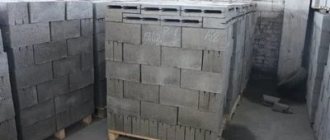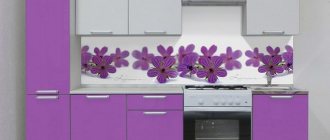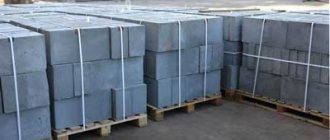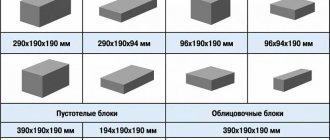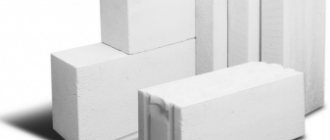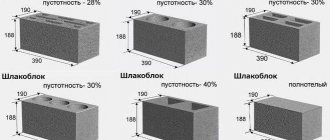The question of how many aerated concrete blocks are in 1m3 is relevant for everyone who is going to use this material in repair and construction work. Aerated concrete is becoming increasingly popular every year, due to its many advantages, being the most optimal choice for the construction of low-rise buildings.
The main advantages of aerated concrete are its low weight and ideal geometry, large size and the ability to quickly build a house with your own hands due to easy and simple installation, a high level of heat conservation and a wide variety of blocks in the assortment. Before starting construction, it is very important to calculate how many blocks are included in the cube and how much material is needed to complete all the work.
The standard size of an aerated concrete block is 60x30x20 centimeters, but manufacturers offer many other dimensions, so before making calculations, you need to decide on the size of the block. Next, they calculate how much material is needed for the construction of all structures (internal partitions and load-bearing walls) in cubic meters, calculate the number of blocks in 1 cubic meter, calculate the required quantity and, taking into account information about the capacity of the pallet, obtain the required value - the exact volume of building material.
How many gas blocks are there in 1m3
To calculate how many gas blocks are in one cube, you need to know the exact dimensions of one unit. This information is indicated among the first in specifications and product descriptions, so after choosing a supplier and the optimal dimensions for the blocks, it will not be difficult to calculate everything.
The blocks come in the following sizes (the most popular): 60x30x20 centimeters, 25x30x60, 60x40x25 centimeters and 32.5x20x25. Typically, large blocks are chosen for laying load-bearing walls; for internal walls, blocks 10-20 centimeters wide are sufficient.
Before the calculations begin, all millimeters/centimeters are converted into a single measurement system - into meters: to obtain values when indicated by the manufacturer, millimeters must be divided by 1000, centimeters - by 100. Thus, the sides of a block of 600x300x200 millimeters or 60x30x20 centimeters will be equal to 0.6x0.3x0. 2 in meters.
Now you need to find out how much volume is equal to one gas block: multiply all sides by 0.6x0.3x0.2, it turns out 0.036. This is exactly how much volume one standard size block can hold. Now 1 cubic meter needs to be divided by 0.036 - and the number of blocks in 1 cube is obtained: 1/0.036=27.7=28. This means that one cubic meter contains 28 blocks of standard size 60x30x20 centimeters.
To understand how to use this in practice, you can consider an example of calculating the number of blocks in cubic meters for one house.
It is difficult to calculate how many blocks are needed to build a wall using the exact dimensions of the material. It is much easier to calculate the required volume in cubic meters, and then count the number of blocks.
An example of calculating gas blocks for a house:
- Initial data
– box 4 by 6 meters, height 3 meters. 3 windows measuring 1.5x1.5 meters and a door 2x1 meter will be installed. The thickness of the walls is 30 centimeters (0.3 meters).
- Calculating the volume of walls
– (6+4+6+4)x3x0.3=18 cubic meters.
- Accounting for windows and doors
– (1.5+1.5)x3x0.3=2.7 (windows), 2+1=3x0.3=0.9 (door). It turns out 2.7+0.9=3.6.
- Volume of material
– 18 – 3.6 = 14.4 cubic meters.
- It was calculated above that 28 standard size aerated concrete blocks fit in one cubic meter - which means that for 14.4 cubic meters you need: 14.4x28 = 403 blocks.
How many gas blocks 20x30x60 in 1 cubic meter
The calculation algorithm was presented above and they are quite simple if you think about the essence and understand what is being done and why.
How to calculate the number of gas blocks 20x30x60 centimeters per cubic meter:
- To obtain the desired value, you first need to find out how many cubic meters fit in one gas block. To do this, all sides of the block, converted to a single value (meters), are multiplied: 0.6x0.3x0.2 = 0.036 gas blocks in one cubic meter.
- Now you can find out how many blocks are included in 1 cubic meter: for this, the number of meters (1) is divided by the volume occupied by one block (0.036) - it turns out 27.7, roughly speaking, 28 pieces.
If the dimensions of aerated concrete are different, the corresponding values are substituted. To make the calculations more clear, you can create simple formulas.
Finding the volume occupied by a block:
height x width x length = volume of one block
.
Finding the number of blocks in 1 m3:
1 / volume of one block = number of gas blocks per cubic meter
.
How many aerated concrete blocks in 1 m3 in a pallet?
To calculate how many blocks fit on a pallet, you need to know exactly the dimensions of the blocks and the size of the pallet. As a rule, a pallet holds 40-180 blocks, depending on their size. But pallets can also be different, so usually when ordering material, this parameter is obtained from the manager. Knowing how many pieces of aerated concrete a pallet can hold, they indicate their number, and can also understand whether it will be possible to deliver aerated concrete in one transport trip.
On the other hand, cubic meters are usually used to calculate the number of gas blocks needed for work. The same indicator is indicated when ordering material, and the buyer is not particularly concerned about the number of pallets. But if you want to organize the delivery of gas blocks to the site yourself, it happens that you need to know the number of pieces on the pallet.
The table below shows the number of blocks of different sizes on pallets:
Features of transportation of building materials
Before construction begins, the blocks must be delivered to the site. During transportation, special attention is paid to the integrity and preservation of the properties of the cargo. Aerated concrete is a rather fragile material that can be damaged when loading or unloading vehicles. Pallets must be loaded in one row with a distance of 5 cm between them to avoid collisions. Packages must be securely secured using straps made of soft material. The speed of freight transport should not exceed 70 km/h on an asphalt road and 40 km/h on a road with poor quality. Soft ropes are used for unloading. The unloading itself is done using a crane, one pallet at a time.
Compliance with all requirements during transportation allows you to maintain the quality of the building material Source storage.bloxy.ru
Weight
The weight of an aerated block, just like its size, can be very different and depends not only on the dimensions, but also on the density. The higher the density of concrete, the more it weighs.
Types of aerated concrete by weight and density:
- The lightest
– they have many pores, the density is minimal, the material is usually used as insulation; it is not suitable for laying walls due to its low strength. The mass of such blocks is 200-500 kilograms per cubic meter.
- Heavy aerated blocks
- the most common option. A cubic meter weighs up to 500-900 kilograms. These blocks are ideal for constructing walls of low-rise buildings.
- Extra-heavy gas blocks
– 900-1200 kilograms per cubic meter. Such blocks are used in high-rise construction; they are considered the most durable and dense, but also the heaviest.
In order not to make a mistake when choosing a material, just look at its brand - it corresponds to the density, the number of kilograms per cubic meter. Thus, the brand of aerated block D400 indicates that the density of the material is 400 kg/m3, D600 – 600 kg/m3, etc.
Density
The density of a material, as stated above, is directly related to its weight and strength. The connection is this: the denser the aerated concrete, the higher its strength and weight, and also the lower its heat-saving abilities. Therefore, the choice for the master is always difficult: either choose a durable and dense, heavy material (which will complicate installation and make the house less warm), or build from a loose material of low strength, which will be light and provide the best thermal insulation and sound insulation properties.
Aerated concrete blocks are divided into grades, which indicate not just numbers, but density, the number of kilograms of material per cubic meter. D200 brand blocks have a density of 200 kg/m2 - that is, their weight is 200 kilograms per cubic meter.
The density of aerated concrete varies by the volume of the gas-forming agent in the composition of the material. The blocks are made from a mixture of cement, water, sand and aluminum powder. The volume of bubbles in the composition can vary between 20-90%. Air bubbles in the structure directly affect the density and strength - the more of them, the less dense and durable the material, but the higher the heat saving rate.
For the construction of residential buildings with 2-3 floors, aerated concrete with a density of 400-500 kilograms per cubic meter is most often chosen. This is the most optimal ratio of characteristics.
Performance characteristics of aerated concrete
Aerated concrete is considered an ideal material for individual construction. This is due to its excellent performance characteristics and optimal cost. The main advantages of gas blocks are:
Advantages of aerated concrete blocks
- ease of processing. Aerated concrete blocks can be easily sawed in any direction and given the desired shape;
- low thermal conductivity , which provides excellent heat-saving characteristics and allows you to save on insulation;
- ensuring high noise insulation parameters , which is important in urban environments;
- absolute safety for humans and the environment;
- fungus and mold cannot grow on aerated concrete blocks ; they do not require additional antiseptic treatment;
- aerated concrete is quite durable. With its help it is allowed to erect buildings up to two floors;
- high frost resistance , the ability to withstand many cycles of freezing and thawing without loss of strength characteristics;
- the light weight of the blocks makes it easier to work with them and does not require the use of special equipment during installation.
The disadvantages of aerated concrete include the presence of a porous structure. This results in it having a high level of moisture absorption. Aerated concrete blocks are very fragile. They are recommended for use in conjunction with foundations that have minimal shrinkage. This drawback makes it quite difficult to attach massive and heavy objects to a wall made of aerated concrete.
One of the main disadvantages of aerated concrete is fragility
Options
The sizes of gas blocks can be very different, as well as the shape and design. Blocks for laying walls are usually made in the shape of a large parallelepiped. An example of a standard size is 60 centimeters in length, 30 centimeters in height and 20 in width. Several other standard sizes are also common, but there are also blocks for internal walls (they are smaller), additional elements, and products of special design.
There are two types of gas blocks
For most tasks at construction sites, it is enough to have two types of aerated concrete blocks - conventional rectangular and U-shaped, which are relevant for performing different parts of the structure. In addition, the shape of the blocks can be different.
What types of gas blocks are there by type and shape:
- Rectangular blocks
– used for the construction of internal partitions and external load-bearing walls.
- Reinforced aerated concrete beams
– for creating ceilings. The floors are assembled from T-shaped beams measuring 60x25x20 centimeters, window/door openings are made from U-shaped blocks, which can significantly speed up the installation process and reduce labor costs.
- Arc-shaped gas blocks, lintels
– are used to facilitate the construction process (certain parts of the structure are made from them).
When choosing aerated concrete blocks, it is important to know the production technology of the material. There are two options in total and in general they are similar, but differ in key parameters. The mixture is prepared for pouring into a mold according to the same recipe, but in the case of autoclaved aerated concrete, the solution is poured into one large mold and sent to an autoclave, where it is subjected to high pressure and temperature.
Non-autoclaved aerated concrete is poured into molds and then dried under natural conditions. In this case, the material turns out to be less durable, and there may be chips and peeling on it.
For construction, it is better to choose autoclaved aerated concrete, which may cost more, but demonstrates much higher performance characteristics.
Standard product sizes
The standard block sizes were indicated above (600x300x200 millimeters), and other standard sizes can also be included.
What sizes are usually used:
- Length – from 60 to 62.5 centimeters.
- Height – from 20 to 25 centimeters.
- Width – from 8.5 to 40 centimeters.
Below are the possible options:
U-shaped products are produced with the following parameters
Standard products of this form usually have the following dimensions: 25 centimeters in height, 50-60 centimeters in length and 20-40 centimeters in width. Before purchasing building materials, you must carefully measure everything and calculate how many gas blocks are needed and where. Calculations are carried out according to the same scheme as in the case of conventional gas blocks.
Calculations
To perform calculations and find the required volume of aerated concrete, you first need to correctly calculate the structure. They calculate the height and width of the walls, the dimensions of the entire building, and internal partitions. Then the length of the walls is multiplied by the height and the total area in square meters is obtained. Next, the thickness of the walls is determined and the resulting indicator is multiplied by the thickness in meters (0.2, 0.3, 0.4, which is equal to 20, 30, 40 centimeters, respectively) and the required volume of the gas block in cubic meters is obtained.
After this, you need to find how much cubic volume is per block - multiply all its sides and divide by the resulting figure one. Then it is enough to multiply the number of cubic meters by the number of blocks per cubic meter and get the desired value - the number of pieces of aerated concrete blocks.
Usually, the examples do not take into account the thickness of the seam, so you don’t have to add the classic 7-10% to the resulting figure. The seams can be thin when using special glue or medium thickness if the masonry is carried out using cement-sand mortar.
Despite the fact that a package of glue costs more than an identical volume of masonry mixture, in the end it turns out to save both due to the thickness of the seams and on heating, since the glue does not create cold bridges.
Knowing how many aerated concrete blocks in 1m3 is desirable for everyone who starts construction. Even if all these volumes and figures can be calculated in production or in a store, there will be no doubt about the correctness and correctness of the calculations performed independently.
How to calculate the required number of blocks per house
First of all, measure the length, height and thickness of each wall. These data are multiplied and the volume of building material is determined. It is divided into the volume of a separate block from which the wall will be built. The result is an approximate number of units needed for construction. It is necessary to add 5 to 10% excess to it.
It is necessary to make exact dimensions of all walls Source m-strana.ru

